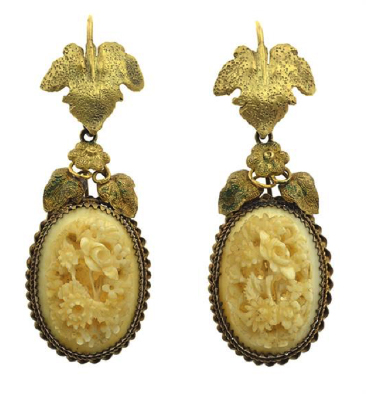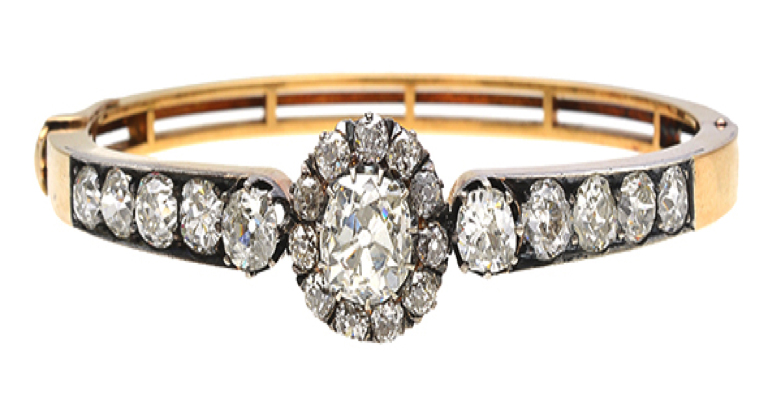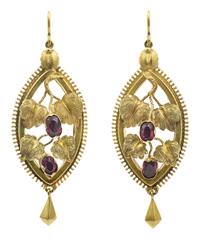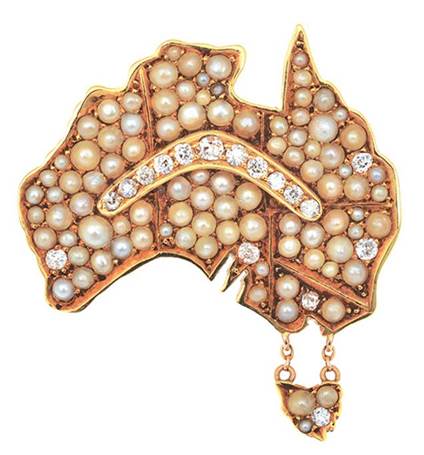Mid 19th to Early 20th Century Australian Jewellery
Articles / May 2019
Over time the jewellers were influenced and inspired by their surroundings. They began integrating the local flora and fauna in their jewellery design, whilst employing their skilful manufacturing techniques and styles.
With the beginning of the gold rush in 1851 there was a large increase in population and individual wealth grew considerably. Consequently, so did the jewellery industry. The native gold was being used in the manufacture of jewellery but from 1851 to 1870 although many pieces were produced they were often not signed and rarely purity marked. Pieces from this period can however be readily
Over time the jewellers were influenced and inspired by their surroundings. They began integrating the local flora and fauna in their jewellery design, whilst employing their skilful manufacturing techniques and styles.


Figure 1. An antique Australian gem-set federation brooch by Wendt. Comprising twelve old European cut diamonds totalling 1.40cts, inter-spaced by a row of six round rubies and six round sapphires, signed Wendt, all mounted in 18ct gold, circa 1900. Sold for $2684 on 14th November, 2015.

Figure 2. A pair of antique Australian gold and ivory earrings. Each featuring a finely carved ivory panel, with applied rope twist decoration and surmounted by engraved leaves and flowers, in 15ct gold. Sold for $3660 on June 22nd, 2015.

Figure 3. Antique Australian cameo brooch by Lamborn and Wagner. The oval shell cameo finely carved depicting a scene of angels, mounted in an elaborate frame with leaf decoration above a hinged panel set with leaf decoration above a hinged panel with tassels, mounted in 15ct gold, signed. Sold for $1830 on 30th November, 2015.

Figure 4. Antique Australian diamond bangle by William Drummond. The oval hinged bangle featuring a flower cluster centrally set with and old European cut diamond of 2.12cts, flanked by ten further graduated diamonds totalling 3.80cts, mounted in 15ct gold and silver. Sold for $14640 30th November, 2015.

Figure 5. A pair of antique Australian gold and garnet drop earrings. Each having a pierced ovoid frarme with leaf decoration set with two oval garnets, mounted in 15ct gold. Sold for $3172 on 22nd June, 2015.

Figure 6. An antique Australian seed pearl and diamond federation brooch by Duggin, Shappere & Co. Modelled as the states of Australia, set throughout with seed pearls and having an old European cut diamond for each capital city, overlaid with a diamond set boomerang, signed all mounted in 15ct gold. Sold for $2928 on 14th November 2015.
With the beginning of the gold rush in 1851 there was a large increase in population and individual wealth grew considerably. Consequently, so did the jewellery industry. The native gold was being used in the manufacture of jewellery but from 1851 to 1870 although many pieces were produced they were often not signed and rarely purity marked. Pieces from this period can however be readily produced was now being marked by jewellery manufacturers to give quality assurance for the buyer. Today we can identify the manufacturer who produced the piece and in the period of manufacturer. The marks of names like Wendt (Adelaide), Taylor and Sharpe (Hobart), Robert Rollason (Sydney), Thomas Richard Scanlan (Perth), to name just a few that are readily identifiable. The national market was strong and growing.
Jewellery manufacturing began in Sydney and Hobart, spreading to all major towns and cities but by the 1860’s Melbourne had become the centre for Australian made jewellery.
With the gold rush the industry boomed and there was an influx of talented gold and silversmiths. Well-known names in Melbourne were Willis, Duggin, Shappere, Aronson and William Lamborn & Leopold Wagner. The “Manufacturing Jewellers Association of Victoria”, the first of its kind, was formed in 1889 and members of the association applied three distinctive marks. The first identified the manufacturer, the second was the purity of gold and the third was a symbol marking to give assurance of workmanship. The mark used was based on the purity of gold. In 1901 the association had 26 makers using these marks.
After the Victorian manufacturers adopted standardized marks in 1889, a particular manufacturer’s mark might change over time, for example if the business changed hands,so providing us with a way of dating a marked item more accurately. Accurate identification of these marks can add a significant premium to a piece offered on the market.
Sydney formed its own association in 1910 and that association chose a Kookaburra as the gold symbol next to the 9ct, 15ct and 18ct gold stamp, and the Wren as the symbol for sterling silver. These symbols were adopted at the national level at a Federal manufacturers’ conference in Brisbane in 1920. There was first to be the maker’s mark, then a date letter commencing in 1923 with the letter ‘A’ and finally the Kookaburra or Wren symbol to show if it was from Sydney, or the Melbourne equivalent.
Unfortunately, this system of marks faded out in Victoria during the 1920’s. The Sydney marking system which was to form the basis for the national system was not embraced by the market and consequently was abandoned in the 1940’s. It was only used consistently for 18 years. The uniquely Australian jewellery produced from the gold rush through to Federation and into the 19th Century is now highly sort after, with record prices being achieved.
If you have a client who has an item for valuation from the golden age of Australian jewellery who may consider putting the piece to auction, please contact our jewellery specialists at Leonard Joel who can provide a current auction appraisal. Any valuer referring a piece or collection to Leonard Joel will be paid a return commission dependant on the final hammer price of the item/items. If you have any questions or wish to discuss further, please feel free to contact me directly.
I look forward to your assistance in discovering the next treasure.
Robert Haigh
Manager, Senior Jewellery Specialist
F.G.A.A, Dip DT
Find A Valuer
Get connected, stay up to date and build your Business
Become A Member
Your membership has expired.
Please contact NCJV to renew
your membership.